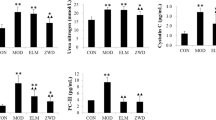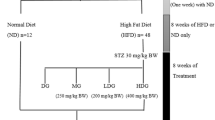Abstract
Hypertension is one of the major risk factor that underlie a wide range of cardiovascular irregularities which causes functional and metabolic alterations in vascular system and major organs. Nitric oxide is the central regulator of the vascular system and its deficiency leads to increased blood pressure and metabolic alterations in liver. Fourier transform infrared spectroscopy (FTIR) is a vibrational spectroscopic technique that uses infrared radiation to vibrate molecular bonds with in the sample that absorbs it and different samples contain diverse configurations of molecular bonds. Both wavenumber and area of the vibrational spectra can be used to explore the qualitative and quantitative constituent of macromolecules. In this study, we intended to evaluate the protective role of borneol, a natural terpene on liver metabolism in a nitric oxide deficient model of hypertension through interpretation of FTIR spectral information. Results demonstrate that FTIR can successfully indicate the molecular changes that occur in all groups. The over all findings demonstrate that in nitric oxide deficient animal model of hypertension, the liver metabolic program is altered through increasing the structural modification in proteins and triglycerides, and quantitative alteration in proteins, lipids, and glycogen. All the above mentioned modifications were protected by borneol in liver and showed its ability to exert a novel defensive action on hepatic metabolism.



Similar content being viewed by others
References
Cohuet GH, Struijker-Boudier (2006) Mechanisms of target organ damage caused by hypertension: therapeutic potential. Pharm Ther 111:81–98. doi:10.1016/j.pharmthera.2005.09.002
Paulis L, Zicha J, Kunes J (2006) Regression of L-NAME induced hypertension the role of NO-pathway and endothelium- derived constricting factor. J Hypertens 24:4–7. doi:10.1291/hypres.31.793
Usui M, Egashira K, Tomita H, Koyanagi M, Katoh M, Shimokawa H (2000) Important role of local angiotensin II activity mediated via type 1 receptor in the pathogenesis of cardiovascular inflammatory changes induced by chronic blockade of nitric oxide synthesis in rats. Circulation 101:305–310. doi:10.1161/01.CIR.101.3.305
Schild L, Dombrowski F, Lendeckel U, Schulz C, Gardemann A, Keilhoff G (2008) Impairment of endothelial nitric oxide synthase causes abnormal fat and glycogen deposition in liver. Biochim Biophys Acta 1782:180–187. doi:10.1016/j.bbadis.2007.12.007
Komiya M, Tkeuchi T, Harada E (2006) Lemon oil vapour causes an anti-stress effect via modulating the activities in mice. Behav Brain Res 172:240–249. doi:10.1016/J.bbr.2006.05.006
Saravana Kumar M, Kumar S, Raja B (2010) Antihypertensive and antioxidant potential of borneol- a natural terpene in L-NAME—induced hypertensive rats. Int J Pharma Bio Arch 1:271–279
Juhas Š, Ikoš Š, Czikkova S, Vesela J, Ilˇkova G, Hajek T, Domoracka K, Domoracky M, Bujnakova D, Rehak P, Koppel J (2008) Effects of borneol and thymoquinone on TNBS-induced colitis in mice. Folia Biol (Praha) 54:1–7. doi:10.1016/j.fct.2009.03.002
Park TJ, Park YS, Lee TG, Ha H, Kim KT (2003) Inhibition of acetylcholine mediated effects by borneol. Biochem Pharmacol 65:83–90. doi:10.1016/S0006-2952(02)01444-2
Toyran N, Zorlu F, Donmez G, Oge K, Severcan F (2004) Chronic hypoperfusion alters the content and structure of proteins and lipids of rat brain homogenates: a Fourier transform infrared spectroscopy study. Eur Biophys J 33:549–554. doi:10.1007/s00249-004-0396-1
Severcan F, Toyran N, Kaptan N, Turan B (2000) Fourier transform infrared study of the diabetes on rat liver and heart tissue in the C-H region. Talanta 53:55–59. doi:10.1016/s0039-9140(00)00379-9
Nadaud S, Dupuis M, Brocheriou I, Haloui M, Louedec L, Capron F, Michel JP, Soubrier F (2009) Counter-regulation by atorvastatin of gene modulations induced by L-NAME hypertension is associated with vascular protection. Vasc Pharma 51:253–261. doi:10.1016/j.vph.2009.06.011
Severcan F, Gorgulu G, Gorgulu TS, Guray T (2005) Rapid monitoring of diabetes-induced lipid peroxidation by Fourier transform infrared spectroscopy: evidence from rat liver microsomal membranes. Anal Biochem 339:36–40. doi:10.1016/j.ab.2005.01.011
Cakmak G, Togan I, Uguz C, Severcan F (2003) FT-IR spectroscopic analysis of rainbow trout liver exposed to nonylphenol. Appl Spectrosc 57:835–841. doi:10.1366/000370203322102933
Voortman G, Gerrits J, Altavilla M, Henning M, Van Bergeijk L, Hessels J (2002) Quantitative determination of faecal fatty acids and triglycerides by Fourier transform infrared analysis with a sodium chloride transmission flow cell. Clin Chem Lab Med 40:795–798. doi:10.1515/CCLM.2002.137
Haris PI, Severcan F (1999) FT-IR spectroscopic characterization of protein structure in aqueous and non-aqueous media. J Mol Catal B 7:207–221
Cakmak G, Togan I, Severcan F (2006) 17-Estradiol induced compositional, structural and functional changes in rainbow trout liver, revealed by FT-IR spectroscopy: a comparative study with nonylphenol. Aquatic Toxico 77:53–63. doi:10.1016/j.aquatox.2005.10.015
Rice-Evans CA, Diplock AT, Symos MCR (1991) Technique in free radical research. New York, Elsevier, pp 207–218
Severcan F (1997) Vitamin E decreases the order of the phospholipids model membranes in the gel phase: an FT-IR study. Biosci Rep 17:231–235
Jackson M, Ramjiawan B, Hewko M, Mantsch HH (1998) Infrared microscopic functional group mapping and spectral clustering analysis of hypercholosterolemic rabbit liver. Cell Mol Biol 44:89–98. doi:S1381-11779900030-2
Horton RA, Ceppi ED, Knowles RG, Titheradge MA (1994) Inhibition of hepatic gluconeogenesis by nitric oxide: a comparisonwith endotoxic shock. Biochem J 299:735–739
Sprangers F, Sauerwein HP, Romijn JA, van Woerkom GM, Meijer AJ (1998) Nitric oxide inhibits glycogen synthesis in isolated rat hepatocytes. Biochem J 330:1045–1049
Kahn BB, Aquier T, Carling D, Hardie DG (2005) AMP-activated protein kinase ancient energy gauge provides clues to modern understanding of metabolism. Cell Metab 1:15–25. doi:10.1016/j.cmet.2004.12.003
Horvathova E, Slamen ova D (2007) Effects of borneol, a bicyclic terpene, on human cells of different origin. Chemicke listy 101:107–109
Slamenova D, Horvathova E, Sramkova M, Labaj J (2007) Toxic, genotoxic and DNA-protective effects of selected plant volatiles on human cells cultured in vitro. In: Durackova Z, Knasmuller S (eds) The activity of natural compounds in diseases prevention and therapy. Slovak Academic Press, Bratislava, pp 149–170
Author information
Authors and Affiliations
Corresponding author
Rights and permissions
About this article
Cite this article
Saravanakumar, M., Manivannan, J., Sivasubramanian, J. et al. Molecular metabolic fingerprinting approach to investigate the effects of borneol on metabolic alterations in the liver of nitric oxide deficient hypertensive rats. Mol Cell Biochem 362, 203–209 (2012). https://doi.org/10.1007/s11010-011-1143-4
Received:
Accepted:
Published:
Issue Date:
DOI: https://doi.org/10.1007/s11010-011-1143-4




